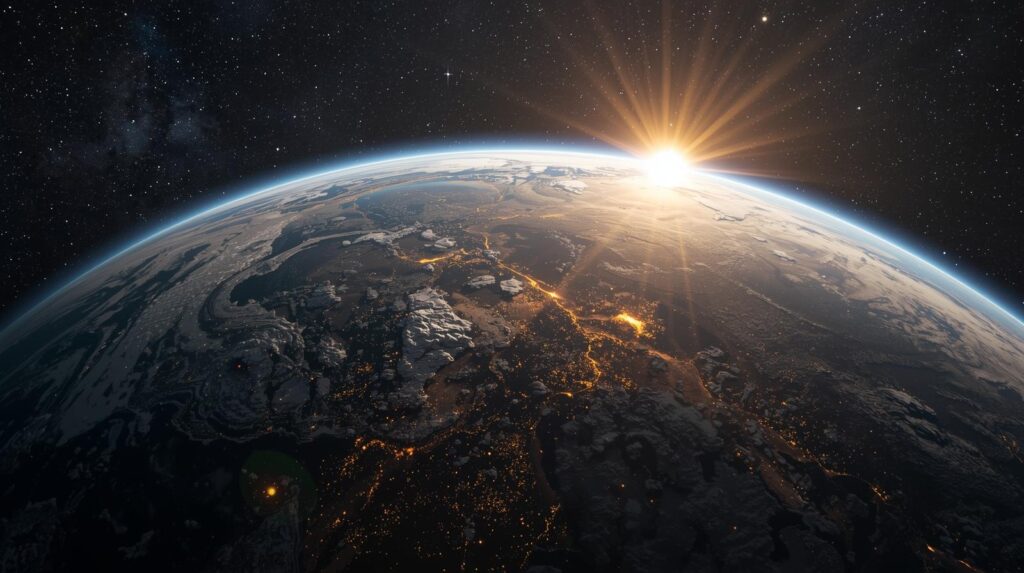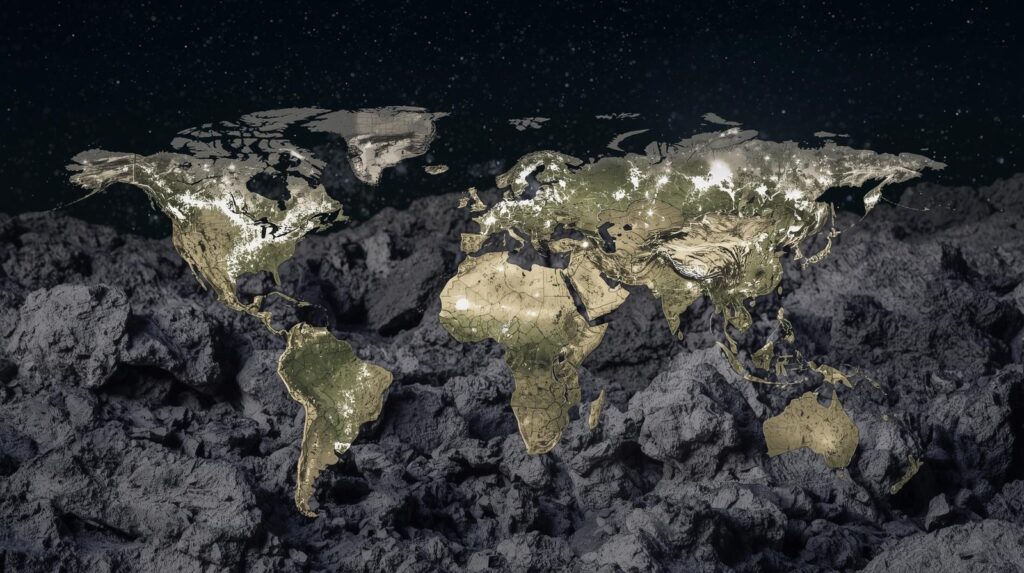Earth’s Epic Oxygen Journey: From Gasping Planet to Breathable Home
Picture Earth as a fiery toddler, fresh out of the cosmic oven 4.5 billion years ago, with atmosphere oxygenation nowhere in sight—just a choking haze of volcanic gases. No oxygen in sight—just a “reducing” mix where chemicals shunned oxygen like a bad date. Ancient rocks whisper this tale, holding clues from those first eons. But over two billion years, tiny microbes, ocean chemistry, and geological drama flipped the script, turning our world into the oxygen haven we know. This is Earth’s atmosphere oxygenation story—a slow-burn epic that birthed complex life and still influences everything from forests to far-off planets. Let’s unpack it casually, with the latest 2025 insights from Nature, and see how we’re nudging this ancient balance today.
The Starting Line: A World Without a Whiff of Oxygen
Earth’s debut atmosphere was no picnic. Born amid cosmic chaos, it was heavy on nitrogen but spiked with methane and CO2 from erupting volcanoes. This setup lasted billions of years, as rocks from places like Western Australia (3.5 billion years old) confirm. It was a “reducing environment,” meaning oxygen-hungry reactions dominated. Weird, heat-loving microbes thrived, but anything needing air? Forget it. This phase set the stage for life’s big pivot.
The Little Green Revolution: Photosynthesis Lights the Fuse
Jump to 2.7–3 billion years ago, and meet the heroes: cyanobacteria. These microscopic wonders were nature’s first solar panels. Via photosynthesis, they harnessed sunlight to crack water molecules, grabbing hydrogen for fuel and dumping oxygen as exhaust. Fossil stromatolites—layered rock mounds built by these microbes—prove they were hard at work. They kickstarted oxygenation, slowly building oxygen in oceans and air. Without these tiny chefs, Earth might still be a methane-choked rock.

The Great Oxidation Event: Earth’s Wake-Up Call
Around 2.4 billion years ago, boom—the Great Oxidation Event (GOE) hit. Oxygen levels jumped, not to modern highs, but enough to rewrite the rules. This surge clashed with dissolved iron in oceans, creating banded iron formations—gorgeous striped rocks that locked oxygen away on the seafloor. The GOE zapped methane, a potent greenhouse gas, chilling the planet and sparking massive glaciations. It was chaotic: Earth’s systems flipped, paving the way for oxygen-tolerant life. But full oxygenation? That was still a long haul.
Roadblocks: Why Oxygen Played Hard to Get
Post-GOE, in the Paleoproterozoic era, oxygen buildup stalled. Blame oxygen sinks—greedy traps like ocean iron and sulfur that devoured oxygen faster than cyanobacteria could produce it. As continents expanded, surface rocks weathered and rusted, guzzling more O2. This “leaky bucket” effect dragged on for millions of years. Recent 2025 research in Nature highlights how these sinks, plus episodic “oxygen whiffs,” kept levels low, supporting early aerobic life in pockets but delaying the big shift.
Banded Iron Formations: Earth’s Rusty Diary
Those banded iron formations chronicle the drama. They boomed from 2.5 to 1.85 billion years ago, as oxygen bonded with iron to form these layered beauties. By 1.85 billion years, they fizzled—oceans had oxidized most iron. Enter red beds, rusty land sediments signaling airborne oxygen. Sulfur and chromium isotopes in rocks seal the deal, showing a gradual awakening. It’s like flipping through Earth’s photo album of change.
The Two-Billion-Year Slog: Why So Long?
Earth’s atmosphere oxygenation wasn’t a sprint—it spanned two billion years. Cyanobacteria churned out oxygen, but ocean reactions and growing continents’ weathering outpaced it. Life-geology feedback loops stretched the timeline: more land meant more rock exposure, more oxygen consumption. 2025 studies emphasize complex cycles—like sulfur and nitrogen—in this delay. It was like building a castle with sand that kept washing away, but persistence paid off.
Lomagundi-Jatuli: A Flashy Oxygen Bash
About 2.2–2.1 billion years ago, oxygen threw a party: the Lomagundi-Jatuli excursion. A carbon-burial bonanza spiked levels temporarily, giving early eukaryotes (complex cells) a boost. This post-GOE blip fueled energy for evolution, hinting at what’s possible with more O2. But it crashed soon after, a teaser for bigger things.
Mid-Proterozoic: The Oxygen Snooze Button
For the next billion years—the Mid-Proterozoic—oxygen flatlined at 1–10% of today’s levels. Deep oceans stayed anoxic, nurturing odd, air-free microbes. Why the lull? Sinks hogged oxygen, and production lagged. This “stasis” paused evolution, a quiet interlude before the next surge. New research calls it a time of “transient oxygen oases,” where life experimented in oxygenated hotspots.
Neoproterozoic: Oxygen’s Big Comeback
Around 850–400 million years ago, the Neoproterozoic Oxidation Event revved up. Oxygen climbed, thanks to Cryogenian glaciations—snowball Earth episodes that rejigged carbon cycles and boosted weathering. Exposed rocks helped oxygen accumulate, ventilating deep oceans. This era bridged the gap to modern levels, priming the pump for life’s explosion.

Ediacaran: When Life Got Squishy and Ambitious
In the Ediacaran (635–541 million years ago), oxygen hit levels for real innovation. Soft-bodied weirdos—like ancient jellyfish kin—emerged in shallow seas. Higher O2 fueled metazoans’ energy needs, letting multicellular life experiment. Fossils from this time tease the Cambrian explosion, when shells and skeletons went viral. Oxygen was the spark for diversity.
Phanerozoic: The Oxygen Golden Age
By the Devonian (410 million years ago), oxygen neared 21%. Vascular plants like ferns supercharged photosynthesis, flooding the air. Swamps buried carbon as coal, curbing O2 loss. This Phanerozoic surge stabilized our atmosphere, enabling dinosaurs, forests, and human civilizations. It was the grand finale of the two-billion-year wait.
Oxygen’s Life Makeover
Impacts of Earth’s oxygenation were huge. Oxygen-phobic anaerobes retreated to vents and mud. Aerobic life boomed, with efficient energy from O2. Eukaryotes nabbed mitochondria, powering multicellular marvels. Bigger oxygen meant bigger critters, smarter brains, wilder behaviors. From sea slugs to soaring eagles, oxygen unlocked evolution’s toolbox.
The Proof in the Pudding: Geological Clues
Rocks don’t lie. Sulfur isotopes quit their weird dance after 2.3 billion years, signaling an ozone layer. Chromium mobilized in soils with rising O2, and red beds shouted oxygen’s arrival. 2025 tools like mass spectrometry and isotope monitoring refine this, using proxies to map ancient air.
Today’s Teetering Balance
Our air’s 21% oxygen is goldilocks-perfect. Photosynthesis from plants and algae supplies it; respiration and decay consume it. But humans are stirring the pot—fossil fuels spew CO2, tweaking cycles and stressing O2 makers. Deforestation slashes producers. It’s fragile; we’re the new variable.
Space Angles: Oxygen as Alien Life Clue
This tale fuels astrobiology. Oxygen’s a “biosignature”—spot it on exoplanets, and it screams life. Earth’s slow oxygenation warns: habitable worlds might take eons to breathe. 2025 isotope studies sharpen our hunt for cosmic kin.
Final Thoughts: Our Oxygen Legacy
Earth’s atmosphere oxygenation transformed a hostile rock into a lively oasis. Cyanobacteria’s whispers grew to the GOE roar, banded irons marked the battles, and plants clinched the win. Delays from sinks and stasis tested patience, but Neoproterozoic surges unleashed Ediacaran oddities and Phanerozoic wonders. Today, this breath fuels us, but fossil fuels risk unraveling it. Let’s honor the journey: plant trees, go green, breathe mindfully. What’s your step to keep Earth’s oxygen story going strong?
